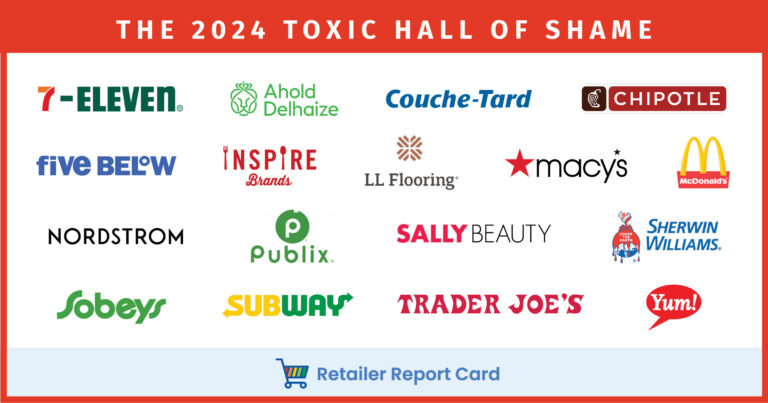Antioxidants
Antioxidants act as stabilizing chemicals that are added to plastics and food packaging to prevent them from degrading, as well as to personal care products and food as preservatives. Antioxidants are widely used in consumer products and some are associated with toxic effects.
How am I exposed to antioxidants?
Individuals can be exposed to antioxidants through skin exposure, inhalation, or ingestion. Antioxidants are added to a variety of consumer products, such as food packaging and personal care products, since they have stabilizing properties that help preserve packaging materials.1 While antioxidants can be found in consumer products, they are not chemically bonded to the materials they are added to, leading to their migration into the environment.2 In addition to consumer products, antioxidants have been detected in environmental samples such as air particles, e-waste dust, residential dust, and sediment.2
Common sources of antioxidants include:
- Personal care products: antioxidants such as butylated hydroxyanisole (BHA) and butylated hydroxytoluene (BHT) can be used in lip products, hair products, sunscreen, fragrances, and deodorant as a preservative.3
- Plastic materials: BHT and Irganox are both types of antioxidants that are added to plastics like polyethylene and polypropylene. Antioxidants in plastics have been found to migrate into oil and food that the plastic comes into contact with.4
- Food packaging: BHT can be added to the plastic or wax lining of food packaging and has been found to migrate into food.4,5
- Food: while many foods contain natural antioxidants which can provide health benefits, synthetic antioxidants such as BHA and BHT are often added to foods to preserve fats and oils.6
Why should I be concerned?
With antioxidants being detected from residential dust to food packaging, there are multiple routes that expose humans to antioxidants. While research on their toxic effects has been limited, studies have raised concerns. In laboratory studies, butylated hydroxytoluene (BHT) caused liver cell damage.7 Butylated hydroxyanisole (BHA) caused cancer in laboratory animals and is considered a possible carcinogen.8 In another laboratory study, diphenylamine was discovered to increase liver, spleen, and kidney weights, as well as increase rates of anemia in rats.9
Antioxidants can also turn into other harmful chemicals. When BHT comes in contact with oxygen, it can turn into a chemical called BHT-Q. BHT-Q is associated with vision disturbances in humans and neurotoxic effects in animals. Like BHT, BHT-Q has also been detected in air, dust, and sediment samples, sometimes at higher levels than BHT itself. 2,10,11
How can I reduce my exposure?
- We can reduce exposures for everyone by winning policies and market actions to reduce plastic and replace harmful antioxidants with safer substitutes. You can let your favorite retailers, brands, as well as policymakers know that you want them to ban harmful antioxidants and make sure substitutes are safer.
- Avoid plastics. And, avoid products that list antioxidants as ingredients (such as butylated hydroxytoluene and diphenyl amine).
- Eating fewer processed foods may also reduce exposure to antioxidants used in such foods.
What’s the solution?
It is impossible for us to shop our way out of this problem. And we shouldn’t have to. When you walk into a store, you should be able to trust that the products on store shelves are safe.
Companies shouldn’t sell products with dangerous chemicals—especially as scientists continue to learn more about the “silent epidemic” caused by the cumulative impact of all the toxic chemicals we are regularly exposed to. And our state and federal governments shouldn’t allow chemicals on the market until they’re proven safe.
The only way to protect everyone from toxic chemicals like antioxidants is to change policies at government and corporate levels to make sure that safer solutions are the norm.
We’re fighting every day to protect you and your loved ones from toxic chemicals like this. To join our fight, please consider making a donation, taking action with us, or signing up for our email list.
Our Key Project
Take Action

Endnotes
-
Groh, K. J., Backhaus, T., Carney-Almroth, B., Geueke, B., Inostroza, P. A., Lennquist, A., Leslie, H. A., Maffini, M., Slunge, D., Trasande, L., Warhurst, A. M., & Muncke, J. (2019). Overview of known plastic packaging-associated chemicals and their hazards. Science of The Total Environment, 651, 3253–3268. https://doi.org/10.1016/j.scitotenv.2018.10.015
-
Wu, Y., Venier, M., & Hites, R. A. (2020). Broad exposure of the North American environment to phenolic and amino antioxidants and to ultraviolet filters. Environmental Science & Technology, 54(15), 9345–9355. https://doi.org/10.1021/acs.est.0c04114
-
Butylated compounds. Safe Cosmetics. (n.d.). Retrieved July 5, 2022, from https://www.safecosmetics.org/get-the-facts/chemicals-of-concern/butylated-compounds/
-
Hahladakis, J. N., Velis, C. A., Weber, R., Iacovidou, E., & Purnell, P. (2018). An overview of chemical additives present in plastics: Migration, release, Fate and Environmental Impact during their use, disposal and recycling. Journal of Hazardous Materials, 344, 179–199. https://doi.org/10.1016/j.jhazmat.2017.10.014
-
Soto-Cantú, C. D., Graciano-Verdugo, A. Z., Peralta, E., Islas-Rubio, A. R., González-Córdova, A., González-León, A., & Soto-Valdez, H. (2008). Release of butylated hydroxytoluene from an active film packaging to asadero cheese and its effect on oxidation and odor stability. Journal of Dairy Science, 91(1), 11–19. https://doi.org/10.3168/jds.2007-0464
-
Shahidi, F., & Ambigaipalan, P. (2015). Phenolics and polyphenolics in foods, beverages and spices: Antioxidant activity and health effects – A Review. Journal of Functional Foods, 18, 820–897. https://doi.org/10.1016/j.jff.2015.06.018
-
Provisional peer-reviewed toxicity values for butylated … – US EPA. Provisional Peer-Reviewed Toxicity Values for Butylated Hydroxytoluene (BHT). (n.d.). Retrieved from https://cfpub.epa.gov/ncea/pprtv/documents/Butylatedhydroxytoluene.pdf
-
Felter, S. P., Zhang, X., & Thompson, C. (2021). Butylated hydroxyanisole: Carcinogenic food additive to be avoided or harmless antioxidant important to protect food supply? Regulatory Toxicology and Pharmacology, 121, 104887. https://doi.org/10.1016/j.yrtph.2021.104887
-
Diphenylamine summary risk assessment report . (n.d.). Retrieved from https://echa.europa.eu/documents/10162/f2e5e682-c52e-40f8-a6a9-4185aa880adc
-
Li, C., Cui, X., Chen, Y., Liao, C., & Ma, L. Q. (2019). Synthetic phenolic antioxidants and their major metabolites in human fingernail. Environmental Research, 169, 308–314. https://doi.org/10.1016/j.envres.2018.11.020
-
U.S. National Library of Medicine. (n.d.). 2,6-di-tert-butyl-p-benzoquinone. National Center for Biotechnology Information. PubChem Compound Database. Retrieved from https://pubchem.ncbi.nlm.nih.gov/compound/2_6-Di-tert-butyl-P-benzoquinone#section=2D-Structure
